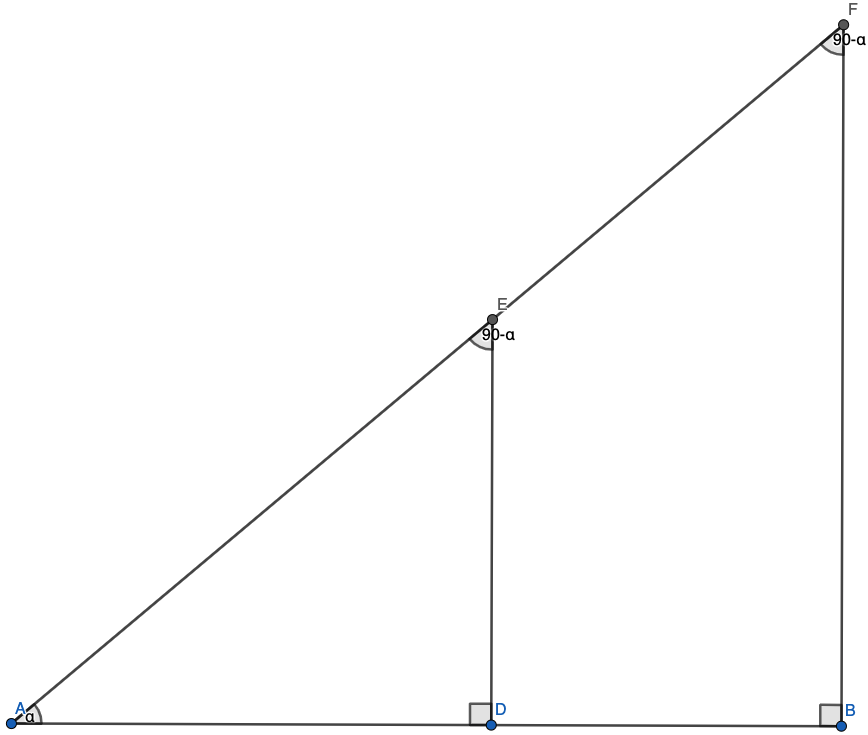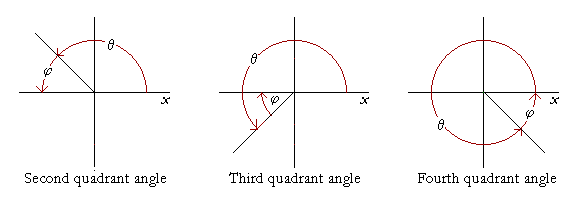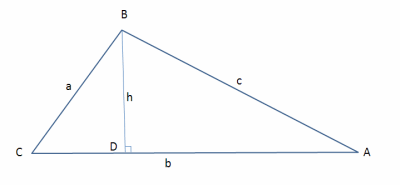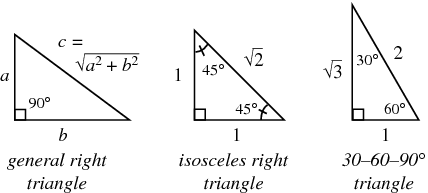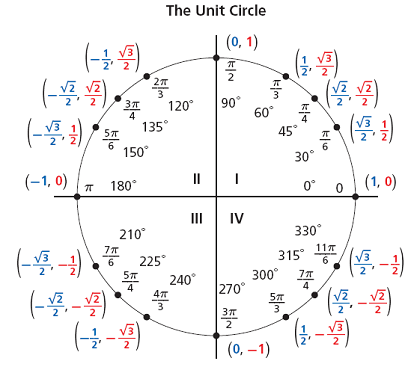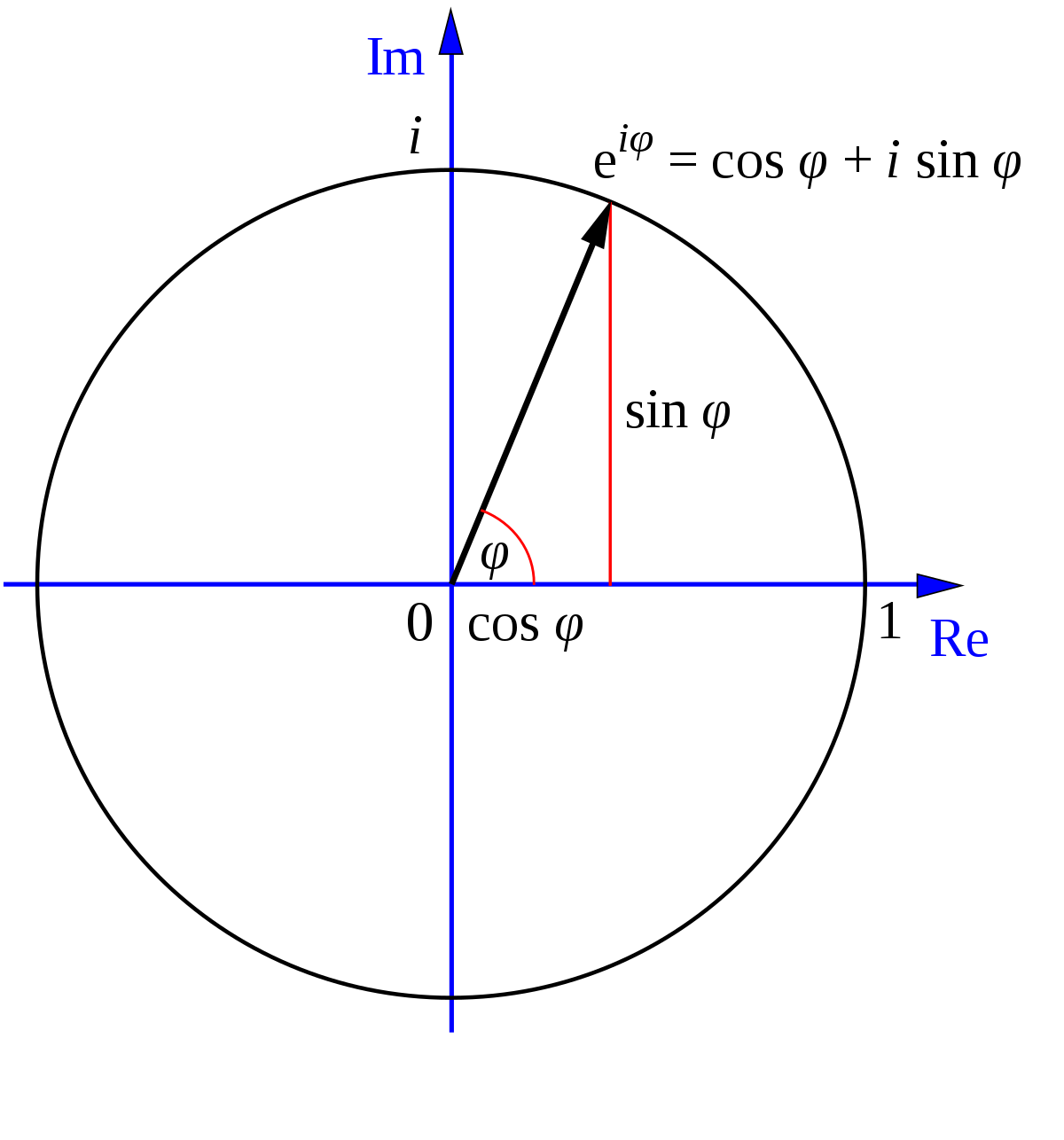Week 7 Notes
- Trigonometric Functions
- Basic Observations
- Extending the domain
- Trigonometric Laws
- Special Right Triangles
- Challenge: Euler's Formula
This week, we'll be learning about Trigonometry! Of course, trigonometry is a vast subject that you will spend nearly a year studying in high school, but we'll try to cover some of the more important results in these notes.
Make sure you have read Week 4's notes before reading these notes.
Trigonometric Functions
Consider the following right triangles:
Both right triangles share an angle \(\alpha\). Since they both also have a right angle, they are similar by \(AA\). Thus, the ratios of their sides are equal.
In particular, we have \(\frac{ED}{EA}=\frac{BF}{AF}\). \(ED\) and \(BF\) are the opposite sides to \(\alpha\) for their respective triangles, and \(EA\) and \(AF\) are the hypotenuses for the respective triangles.
So as long as the angle is fixed (in this case, \(\alpha\)), the ratio of the opposite side to hypotenuse is the same. This is such an important quantity that we give it a name.
From our reasoning earlier, the choice of triangle doesn't matter in calculating the sine. This makes it a very versatile function.
Since the triangles in the diagram above are similar, we also know that \(\frac{AD}{AE}=\frac{AB}{AF}\). \(AD\) and \(AB\) are the adjacent sides to \(\alpha\) of their respective triangles, and \(AE,AF\) are the hypotenuses. This again means that the ratio \(\frac{adj}{hyp}\) is independent of the triangle we choose, and only dependent on the value of \(\alpha\). That leads us to the next definition.
We now define \(4\) more trigonometric functions which we will use regularly.
| Name | Notation | Definition |
|---|---|---|
| Tangent | \(\tan\alpha\) | \(\frac{\sin\alpha}{\cos\alpha}=\frac{opp}{adj}\) |
| Cotangent | \(\cot\alpha\) | \(\frac{\cos\alpha}{\sin\alpha}=\frac{adj}{opp}\) |
| Cosecant | \(\csc\alpha\) | \(\frac1{\sin\alpha}=\frac{hyp}{opp}\) |
| Secant | \(\sec\alpha\) | \(\frac1{\cos\alpha}=\frac{hyp}{adj}\) |
Basic Observations
Now that we have our trigonometric functions, let's make some basic observations.
In our right triangle diagram, observe that the side opposite to \(\alpha\) is adjacent to \(\frac\pi2-\alpha\), and the side adjacent to \(\alpha\) is opposite to \(\frac\pi2-\alpha\). Thus, we have $$\sin\alpha=\cos\left(\frac\pi2-\alpha\right)$$$$\cos\alpha=\sin\left(\frac\pi2-\alpha\right)$$That's certainly a useful observation.
Now given some \(\alpha\), consider \(\sin(\alpha)^2+\cos(\alpha)^2\) (which we write as \(\sin^2\alpha+\cos^2\alpha\)). This equals $$\left(\frac{opp}{hyp}\right)^2+\left(\frac{adj}{hyp}\right)^2=\frac{opp^2+adj^2}{hyp^2}$$But now we use the Pythagorean Theorem! \(opp^2+adj^2=hyp^2\), so $$\sin^2\alpha+\cos^2\alpha=1$$Surprised? Well, what if I told you we actually did this already, in the first week! Don't believe me?
In the first week, we observed that given a Pythagorean triple \(a^2+b^2=c^2\), we could rewrite it as \(\left(\frac ac\right)^2+\left(\frac bc\right)^2=1\). Viewing \(a\) as \(adj\), \(b\) as \(opp\), and \(c\) as \(hyp\) gives us \(\sin^2\alpha+\cos^2\alpha=1\). But this insight is far deeper than you might imagine.
Extending the domain
In Week 1, we noticed that \(\left(\frac ac,\frac bc\right)\) can be viewed as a point on the unit circle. With our rewrite, \((\cos\alpha,\sin\alpha)\) can be viewed as a point on the unit circle. As a demonstration of this principle, click on this Desmos graph to see the green point \((\cos\alpha,\sin\alpha)\) as \(\alpha\) varies from \(0\) to \(\frac\pi2\).
Note that the slope of the hypotenuse is \(\frac{\sin\alpha-0}{\cos\alpha-0}=\tan\alpha\), the hypotenuse has length \(1\), and the angle formed by the \(x\)-axis and the hypotenuse is \(\alpha\)! This suggests that we may want to redefine \(\sin\) and \(cos\) as follows:
The beauty of this new definition is that \(\sin\) and \(\cos\) are now defined for all real numbers, rather than just for \(0\lt\alpha\lt\frac\pi2\). \(\tan\) and \(\sec\) are defined whenever \(\cos\alpha\neq0\), and \(\cot\) and \(\csc\) are defined whenever \(\sin\alpha\neq0\).
If you are still confused by the new definition, see this Desmos graph and watch the relationship between \(\alpha\), the right triangle, and the values of \(\cos\alpha,\sin\alpha\).
- \(\alpha=0\)
- \(\alpha=\frac\pi2\)
- \(\alpha=\pi\)
- \(\alpha=\frac{3\pi}2\)
Trigonometric Laws
Consider an arbitrary \(\triangle ABC\), and draw an altitude \(h\) from \(B\) to \(AC\).
Call \(\angle BCA\) \(\gamma\). Thus, \(\frac ha=\sin\gamma\), so \(a\sin\gamma =h\). Since \(h\) is an altitude, \(\frac12 bh\) is the area. Substituting in our new formula for \(h\), we have $$\text{Area}=\frac12ab\sin \gamma$$This is a very useful formula. Observe, though, that the choice of \(a,b,c\) doesn't really matter. From Week 4, we have \(\frac{abc}{4R}\) as a formula for the area of a triangle as well. If we call \(\angle BAC\) \(\alpha\) and \(\angle CBA\) \(\beta\), we have $$\frac{abc}{4R}=\frac12ab\sin\gamma=\frac12ac\sin\beta=\frac12bc\sin\alpha$$Dividing all of the equations by \(\frac12abc\) gives us $$\frac1{2R}=\frac{\sin\gamma}c=\frac{\sin\beta}b=\frac{\sin\alpha}a$$This is known as the Law of Sines, as it tells us that the ratio between the sine of an angle and the side opposite to it is constant for any triangle (and only dependent on the circumradius, oddly enough).
Now, observe that \(\cos\gamma = \frac{CD}a\), so \(a\cos\gamma = CD\). Thus, \(b-a\cos\gamma=DA\). But, by the Pythagorean theorem, $$DA^2+h^2=c^2$$Substituting our values for \(h\) and \(DA\) into this formula gives us $$a^2\sin^2\gamma+b^2-2ab\cos\gamma+a^2\cos^2\gamma=c^2$$Since \(\sin^2\gamma+\cos^2\gamma=1\), we have $$a^2+b^2-2ab\cos\gamma=c^2$$This equation is called the Law of Cosines, and is also very useful.
Special Right Triangles
In Week 4, we discussed \(2\) special right triangles
We can use these special triangles to figure out values of \(\sin\) and \(\cos\) for certain angles.
Note that $$\sin30^\circ=\sin\frac\pi6=\cos\frac\pi3=\frac12$$since the side opposite to \(30^\circ\) in the \(30-60-90\) triangle is \(1\) and the hypotenuse is \(2\).
Likewise, $$\sin60^\circ=\sin\frac\pi3=\cos\frac\pi6=\frac{\sqrt3}2$$
And, using the isosceles right triangle, we have $$\sin45^\circ=\sin\frac\pi4=\cos\frac\pi4=\frac1{\sqrt2}$$
We can use the relations in New Relationships to generate the following diagram:
You shouldn't memorize most of the material in this week's notes: rather, you should understand the process by which it is derived, and be confident in your ability to figure out similar problems on the fly.
Challenge: Euler's Formula
This section will assume a basic understanding of complex numbers. If you haven't seen them before, I'd suggest just glancing through the conclusions of this section, and ignoring Euler's Formula and the derivations
In the previous sections, we viewed \((\cos\theta,\sin\theta)\) as a point on the unit circle in the plane. What if we replaced the plane with the complex numbers? In this case, the \(x\)-axis becomes the real numbers, and the \(y\)-axis the imaginary numbers. In this case, \((\cos\theta,\sin\theta)\) would become \(\cos\theta+i\sin\theta\).
What makes this such a powerful way of representing trigonometric functions is Euler's Formula, widely regarded by mathematicians as one of the most beautiful, if not the most beautiful, formula in all of mathematics.$$e^{i\theta}=\cos\theta+i\sin\theta$$If you don't really understand the formula, or don't get the hype yet, don't worry. We'll work through some of the more basic implications of this formula, although a full study of this formula would take years.
Polar Form
Suppose I have the complex number \(a+bi\). Then, the distance of this complex number from the origin, known as the magnitude of the complex number, is \(\sqrt{a^2+b^2}\). Call this value \(r\). So, we have \(a^2+b^2=r^2\).
As we did above, we divide both sides by \(r^2\). We get $$\left(\frac ar\right)^2+\left(\frac br\right)^2=1$$Thus, we have a right triangle, with \(\frac ar\) as the horizontal leg of the right triangle, \(\frac br\) as the vertical leg of the right triangle, and \(1\) as the hypotenuse. Let \(\alpha\) be the angle of this triangle.
So, \(\cos\alpha=\frac ar\), \(\sin\alpha =\frac br\), so \(r\cos\alpha + ri\sin\alpha=a+bi\). Thus, we can write $$a+bi=re^{i\alpha}$$This way of writing complex numbers is called polar form, since instead of writing the horizontal and vertical components of the complex number, we write the magnitude (how far it is from the origin) and the angle (the angle the line segment from the origin to the number makes with the positive \(x\)-axis).
Now, you may be wondering, why would you bother to do this? The answer is simple: multiplication. Suppose I wanted to multiply complex numbers \(a+bi,\;c+di\). Pretty painful, isn't it? Instead, what if I wanted to multiply \(re^{i\theta}\) with \(se^{i\alpha}\). Easy! We have $$re^{i\theta}\cdot se^{i\alpha}=rs\cdot e^{i(\theta+\alpha)}$$since \(e^a\cdot e^b=e^{a+b}\). This is great, since it tells us that the product of two complex numbers is the complex number with magnitude equal to the product of the magnitudes of the numbers we multiply, and angle equal to the sum of the angles of the numbers we multiply. Cool, huh?
De Moivre's Theorem
Euler's Formula also allows us to compute \(\cos\) and \(\sin\) for some trickier angles.
From Euler's Formula and the new relationships, it should be obvious that $$\cos\theta=\frac{e^{i\theta}+e^{-i\theta}}2,\;\sin\theta=\frac{e^{i\theta}-e^{-i\theta}}{2i}$$But there's a more subtle takeaway from the formula. If \(\mathcal{Re}(a+bi)=a\) and \(\mathcal{Im}(a+bi)=b\) for all complex numbers \(a+bi\), then $$\cos\theta=\mathcal{Re}(e^{i\theta}),\;\sin\theta=\mathcal{Im}(e^{i\theta})$$
Without Euler's Formula, deriving the formulas in the example above would have been much, much more difficult. Let's derive some more formulas!
From this example, we can see that $$\cos(n\alpha)+i\sin(n\alpha)=e^{ni\alpha}=(e^{i\alpha})^n=(\cos\alpha+i\sin\alpha)^n$$This formula is known as De Moivre's Theorem, and is really hard to memorize, but is very easy to remember if we know Euler's Formula.
There are so many more formulas that we can derive by playing around with Euler's Formula. What's amazing about it is that all of these formulas are somehow buried in a simple, one-line formula. Now that's a powerful formula.
